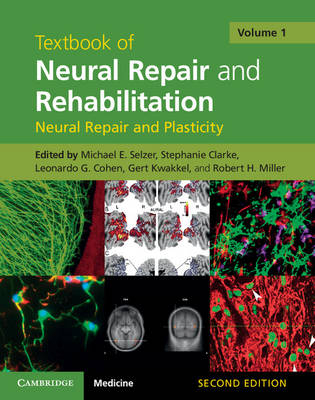
Textbook of Neural Repair and Rehabilitation
Cambridge University Press (Verlag)
978-1-107-01167-0 (ISBN)
- Titel ist leider vergriffen;
keine Neuauflage - Artikel merken
In two freestanding volumes, the Textbook of Neural Repair and Rehabilitation provides comprehensive coverage of the science and practice of neurological rehabilitation. Revised throughout, bringing the book fully up to date, this volume, Neural Repair and Plasticity, covers the basic sciences relevant to recovery of function following injury to the nervous system, reviewing anatomical and physiological plasticity in the normal central nervous system, mechanisms of neuronal death, axonal regeneration, stem cell biology, and research strategies targeted at axon regeneration and neuron replacement. New chapters have been added covering pathophysiology and plasticity in cerebral palsy, stem cell therapies for brain disorders and neurotrophin repair of spinal cord damage, along with numerous others. Edited and written by leading international authorities, it is an essential resource for neuroscientists and provides a foundation for the work of clinical rehabilitation professionals.
Michael Selzer is Director and Professor, Department of Neurology at Shriners Hospitals Pediatric Research Center, Temple University School of Medicine, Philadelphia, PA, USA. Stephanie Clarke is Professor, Service de Neuropsychologie et de Neuroréhabilitation, Centre Hospitalier Universitaire Vaudois, Université de Lausanne, Switzerland. Leonardo Cohen is Professor, Human Cortical Physiology Section and Stroke Neurorehabilitation Section, National Institutes of Neurological Disorders and Stroke, National Institutes of Health, Bethesda, MD, USA. Gert Kwakkel is Professor of Rehabilitation Medicine, Move Research Institute, VU University Medical Center (VUmc), Amsterdam; Centre of Excellence for Rehabilitation Medicine, Rehabilitation Centre 'De Hoogstraat' and Department of Rehabilitation and Sports Medicine, Rudolf Magnus Institute of Neuroscience, UMC Utrecht, Utrecht, The Netherlands. Robert Miller is Vice Dean for Research, Department of Neuroscience, Center for Translational Neuroscience, Case Western Reserve University, Cleveland, OH, USA.
Part I. Neural Plasticity – Cellular and Molecular Mechanisms of Neural Plasticity: 1. Degenerative changes and reactive growth responses of neurons following denervation and axotomy: historical concepts and their modern embodiments; 2. Learning and memory: basic principles and model systems; 3. Short-term plasticity: facilitation, augmentation, potentiation and depression; 4. Long-term potentiation and long-term depression; 5. Cellular and molecular mechanisms of associative and nonassociative learning; Part II. Functional Plasticity in the Central Nervous System: 6. Plasticity of mature and developing somatosensory systems; 7. Activity-dependent plasticity in the intact spinal cord; 8. Plasticity of cerebral motor functions: implications for repair and rehabilitation; 9. Plasticity in visual connections: retinal ganglion cell axonal development and regeneration; 10. Plasticity in auditory functions; 11. Cross-modal plasticity in the visual system; Part III. Plasticity after Injury to the Central Nervous System: 12. The role of extracellular matrix in plasticity in the spinal cord; 13. Spinal plasticity underlying the recovery of locomotion after injury; 14. Cellular mechanisms of plasticity after brain lesions; 15. Pathophysiology and plasticity in cerebral palsy; 16. Noninvasive brain stimulation in cognitive rehabilitation: guiding plasticity after injury to the central nervous system; 17. From bench to bedside: influence of theories of plasticity on human neurorehabilitation; Part IV. Neural Repair – Basic Cellular and Molecular Processes: 18. Neuronal death and rescue: neurotrophic factors and anti-apoptotic mechanisms; 19. Axon degeneration and rescue; 20. Adult neurogenesis and neural precursors, progenitors, and stem cells in the adult central nervous system; 21. Axon guidance during development and regeneration; 22. Synaptogenesis; Part V. Determinants of Regeneration in the Injured Nervous System: 23. Non-mammalian models of nerve regeneration; 24. Myelin-associated axon growth inhibitors; 25. Inhibitors of axonal regeneration; 26. Glial development and their role in axon regeneration; 27. Effects of the glial scar and extracellular matrix molecules on axon regeneration; 28. The role of the inflammatory response in central nervous system injury and regeneration; 29. Neurotrophin repair of spinal cord damage; 30. Intraneuronal determinants of regeneration; Part VI. Promotion of Regeneration in the Injured Nervous System: 31. Cellular replacement in spinal cord injury; 32. Dysfunction and recovery in demyelinated and dysmyelinated axons; 33. Role of Schwann cells in peripheral nerve regeneration; 34. Transplantation of Schwann cells and olfactory ensheathing cells as a therapeutic strategy in spinal cord injury; 35. Trophic factor delivery by gene therapy; 36. Assessment of sensorimotor function after experimental spinal cord injury and repair; Part VII. Translational Research: Application to Human Neural Injury: 37. Biomimetic design of neural prostheses; 38. Brain responses to neural prostheses; 39. Brain-computer interfaces; 40. Intracranial brain-computer interfaces for communication and control; 41. Stem cell therapies for brain disorders; 42. Understanding motor recovery and compensation in neurorehabilitation; Index.
| Erscheint lt. Verlag | 24.4.2014 |
|---|---|
| Reihe/Serie | Textbook of Neural Repair and Rehabilitation 2 Volume Hardback Set ; Volume 1 |
| Zusatzinfo | 13 Tables, black and white; 59 Plates, color; 55 Halftones, unspecified; 97 Line drawings, unspecified |
| Verlagsort | Cambridge |
| Sprache | englisch |
| Maße | 223 x 283 mm |
| Gewicht | 2120 g |
| Themenwelt | Medizin / Pharmazie ► Medizinische Fachgebiete ► Neurologie |
| Physiotherapie / Ergotherapie ► Rehabilitation ► Neuro-Rehabilitation | |
| ISBN-10 | 1-107-01167-1 / 1107011671 |
| ISBN-13 | 978-1-107-01167-0 / 9781107011670 |
| Zustand | Neuware |
| Haben Sie eine Frage zum Produkt? |
aus dem Bereich


